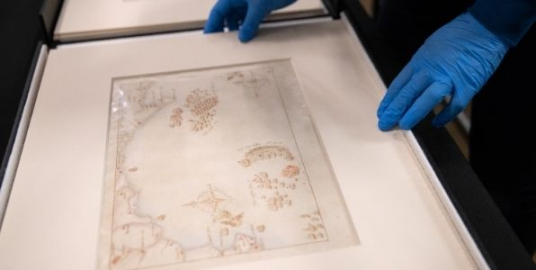National Museum of The Royal Navy Saves Incredibly Rare Spanish Armada Maps for the Nation
- View news filtered by: Professional Navy
- View news filtered by: War and Peace
- View news filtered by: Battles
- View news filtered by type: Press Release

The National Museum of the Royal Navy is proud to announce that in just eight weeks the fundraising campaign to save the Armada Maps for the nation was successful and these incredibly rare maps will now remain in the UK. The maps, a complete set, are thought to be the earliest surviving representations of the naval battles and have not left the United Kingdom since they were first drawn in 1589.
They were secured thanks to two essential grants from the National Heritage Memorial Fund and the Art Fund; and the generous support of the British public. Those of you who would still like to support the ongoing conservation of the Armada Maps can do so on the National Museum of the Royal Navy donation page.
Professor Dominic Tweddle, Director General of the National Museum of the Royal Navy commented:
Like many cultural and heritage institutions 2020 was an exceptionally tough year but we rallied and I am incredibly proud that we have made sure that the Armada Maps have been saved for generations to come. I would take this opportunity to place on record my gratitude to all those who answered our call to help. It was an amazing response from our funding partners and the public, who dug deep in extremely difficult times, to save these treasures.
These ten ink and watercolour ‘Armada Maps’ present a defining moment in England’s national and naval history. They depict in real time a Navy defending England’s shores against invasion by the 16th century’s imperial super-power of Spain, with each map detailing the position in the Channel of individual ships in the English and Spanish fleets. The defeat of the Armada and the 16th century’s super-power was a turning point in forging England’s complex identity as it developed into the modern age.
The maps offer the opportunity to explore the role of the Navy throughout history as a protector of an Island Nation. Museums are uniquely placed to work with people and communities to provide space and opportunities to explore issues on a social and political level particularly now as the UK enters a new phase in our role on the global stage.
Culture Minister Caroline Dinenage said:
The Armada Maps, first drawn in 1589, are an important piece of British heritage serving to remind us of this pivotal naval battle. The export bar system exists so we can keep nationally important works in the country and I am delighted that, thanks to the tireless work of the National Museum of the Royal Navy, the Armada Maps will now go on display to educate and inspire future generations.
René Olivieri, Interim Chair of the National Heritage Memorial Fund, said
We at the National Heritage Memorial Fund are delighted to support the acquisition of these rare and significant maps, which illustrate in incredible detail the defeat of the Spanish Armanda, a key moment in England’s history. By safeguarding them from export, we can ensure that these maps remain in the UK as they have done since the 16th century. We’re proud that the Spanish Armada maps will join the wide range of iconic artefacts and places across the UK that the NHMF has played a vital role in saving for the nation.
Sarah Philp, Director of Programme and Policy for Art Fund stated
Art Fund is so pleased to help save these irreplaceable maps for the nation, which not only evoke an iconic event in the history of England, but prompt reflection on the influence that history has on the present day. I know they will enthral visitors when they go on public display for the first time at the National Museum of the Royal Navy. As a charity, Art Fund relies on the generosity of its 159,000 members, and we are especially grateful to them for continuing to support the vital work of developing collections, during this very challenging time for museums.
To ensure that the maps can be viewed and enjoyed by members of the public for a first time a new phase of fundraising has now started. The National Museum of the Royal Navy wishes to place the maps on display during 2021 and has longer term plans for them to tour the country when current COVID restrictions permit.
Sponsors or partners wishing to support the campaign to support the display and tour are encouraged to contact fundraising@nmrn.org.uk